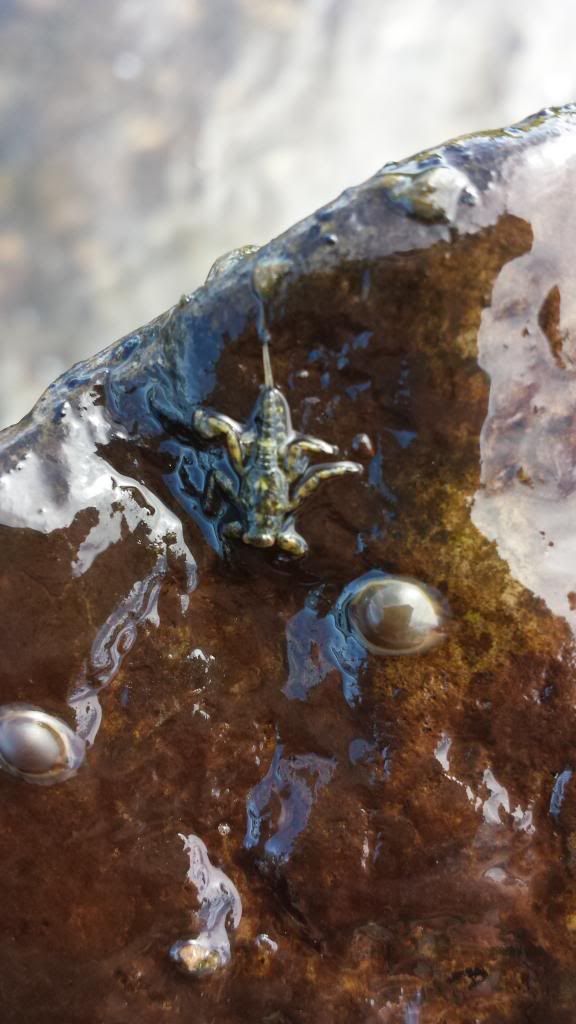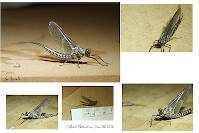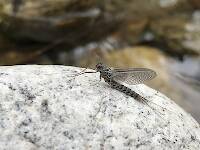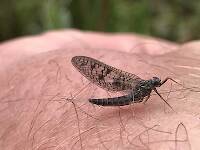
Hex Mayflies
Hexagenia limbata
The famous nocturnal Hex hatch of the Midwest (and a few other lucky locations) stirs to the surface mythically large brown trout that only touch streamers for the rest of the year.
Featured on the forum

This one was surprisingly straightforward to identify. The lack of a sclerite at the base of the lateral hump narrows the field quite a bit, and the other options followed fairly obvious characteristics to Clostoeca, which only has one species, Clostoeca disjuncta.

Troutnut is a project started in 2003 by salmonid ecologist Jason "Troutnut" Neuswanger to help anglers and
fly tyers unabashedly embrace the entomological side of the sport. Learn more about Troutnut or
support the project for an enhanced experience here.
Konchu on Dec 17, 2013December 17th, 2013, 1:46 pm EST
Where is this from?
Taxon on Dec 17, 2013December 17th, 2013, 3:10 pm EST
Mack-
It is generally not productive to offer an opinion concerning the identity of a photo of a mayfly nymph, unless it has been photographed while fully immersed in water. Otherwise, all its appendages stick together, and it simply resembles a blob.
When in the field, a pickle jar lid is handy for that purpose.

Roger will know for sure.
It is generally not productive to offer an opinion concerning the identity of a photo of a mayfly nymph, unless it has been photographed while fully immersed in water. Otherwise, all its appendages stick together, and it simply resembles a blob.
When in the field, a pickle jar lid is handy for that purpose.
Byhaugh on Dec 17, 2013December 17th, 2013, 6:14 pm EST
It was from The Ranch on the Henry's Fork in Idaho
Entoman on Dec 17, 2013December 17th, 2013, 11:43 pm EST
Good guess as to genus, Mack. I have sampled the Henrys quite a bit, though it has been many years. If memory serves, the smaller flav species were mostly bland there. The bright mottled appearance was common with the big green drakes but it's what appears to be paired thoracic tubercle development that makes this specimen look more like an immature D. grandis (Green Drake) to me. This is only probable, though. Roger stated the difficulties with making determinations using this kind of photo very well so I won't comment further other than to express my agreement.
"It's not that I find fishing so important, it's just that I find all other endeavors of Man equally unimportant... And not nearly as much fun!" Robert Traver, Anatomy of a Fisherman
Entoman on Dec 18, 2013December 18th, 2013, 10:04 am EST
How much color variation is common or normal in the Drunella group ???
All over the map, Mack. They are little chameleons and tend to take on the coloration of their surroundings. Mostly, they live in weeds or the detritus between rocks and so tend to shades of olive or brownish black. On less fertile streams full of assorted colorful rocks, these critters are just as varied. I've collected them in suits of granite looking salt & pepper and even bright chartreuse w/ black tiger stripes. Go to http://www.flyfishingentomology.com/forum/Topics_Display.php and check out the various Drunella photos there. Some are very colorful odd balls.:)
"It's not that I find fishing so important, it's just that I find all other endeavors of Man equally unimportant... And not nearly as much fun!" Robert Traver, Anatomy of a Fisherman
Quick Reply
Related Discussions
Topic
Replies
Last Reply
2
Aug 2, 2019
by Crepuscular
by Crepuscular
4
Jun 17, 2020
by Leskorcala
by Leskorcala
1
Apr 18, 2007
by Troutnut
by Troutnut
2
Dec 15, 2011
by PaulRoberts
by PaulRoberts








